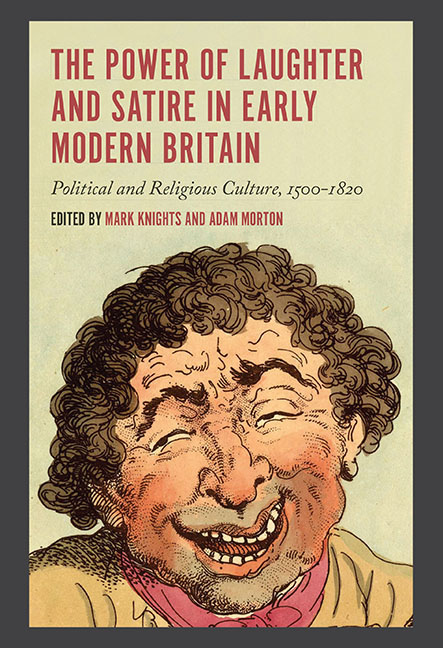Book contents
- Frontmatter
- Contents
- List of Illustrations
- List of Contributors
- Acknowledgements
- List of Abbreviations
- Introduction: Laughter and Satire in Early Modern Britain 1500–1800
- 1 Dissolving into Laughter: Anti-Monastic Satire in the Reign of Henry VIII
- 2 Mocking or Mirthful? Laughter in Early Modern Dialogue
- 3 Farting in the House of Commons: Popular Humour and Political Discourse in Early Modern England
- 4 Continuing Civil War by Other Means: Loyalist Mockery of the Interregnum Church
- 5 Laughter as a Polemical Act in Late Seventeenth-Century England
- 6 Spectacular Opposition: Suppression, Deflection and the Performance of Contempt in John Gay's Beggar's Opera and Polly
- 7 ‘Laughing a Folly out of Countenance’: Laughter and the Limits of Reform in Eighteenth-Century Satire
- 8 Nervous Laughter and the Invasion of Britain 1797–1805
- 9 ‘Was a laugh treason?’ Corruption, Satire, Parody and the Press in Early Modern Britain
- Bibliography
- Index
8 - Nervous Laughter and the Invasion of Britain 1797–1805
Published online by Cambridge University Press: 01 September 2018
- Frontmatter
- Contents
- List of Illustrations
- List of Contributors
- Acknowledgements
- List of Abbreviations
- Introduction: Laughter and Satire in Early Modern Britain 1500–1800
- 1 Dissolving into Laughter: Anti-Monastic Satire in the Reign of Henry VIII
- 2 Mocking or Mirthful? Laughter in Early Modern Dialogue
- 3 Farting in the House of Commons: Popular Humour and Political Discourse in Early Modern England
- 4 Continuing Civil War by Other Means: Loyalist Mockery of the Interregnum Church
- 5 Laughter as a Polemical Act in Late Seventeenth-Century England
- 6 Spectacular Opposition: Suppression, Deflection and the Performance of Contempt in John Gay's Beggar's Opera and Polly
- 7 ‘Laughing a Folly out of Countenance’: Laughter and the Limits of Reform in Eighteenth-Century Satire
- 8 Nervous Laughter and the Invasion of Britain 1797–1805
- 9 ‘Was a laugh treason?’ Corruption, Satire, Parody and the Press in Early Modern Britain
- Bibliography
- Index
Summary
Laughing Gas
From 1797 to 1798 and again between 1803 and 1805, there was an outpouring of prints depicting Napoleon Bonaparte and the threatened – on many accounts, impending – invasion of Britain. The unequivocal message of the prints was that Bonaparte and the French army posed a credible threat to Britain, in particular around the south coast where the crossing of the English Channel, or La Manche, seemed an eminently practical possibility. Some prints were clearly fanciful and humorous, but even these had more serious components. For example, Isaac Cruickshank's scatological Bonne Farte Raising a Southerly Wind (Plate I: 1798) depicts Bonaparte bent over, his breeches pulled down, being fed a purgative to enable him to fart a stream of invasion balloons, men on horseback, guillotines and sundry military forces and apparatus across the channel. On the right, a huge fish delivers up members of the French Assembly to Dover, including Gaspard Monge, the mathematician credited with designing a giant raft for the invasion, to be welcomed by Charles James Fox who comments on the fragrant breeze. At the centre of the scene, in the middle distance, is Monge's huge invasion raft surrounded by accompanying smaller vessels. This representation is dramatically more realistic than most of the other elements in the picture.
Did people at the time think that this print was funny? How did they react and how were they meant to react to the invasion raft? It is one of the more popular prints today but it raises some difficult questions about who would laugh at it and why, and what the relationship might be between the humorous elements and the more realistic representations of danger in the print. And those questions need to be answered if we are to understand the creation and publishing of caricatures and popular prints, how designers and engravers might have conceived of what they were doing and the place that prints had in the political culture of the period.
One possible source for the printmakers’ construction of their craft, albeit much critiqued in the eighteenth century, was Hobbes's suggestion that ‘Laughter is nothing else but sudden Glory, arising from some sudden Conception of some Eminency in our selves, by comparison with the infirmity of others, or with our own formerly.’
- Type
- Chapter
- Information
- The Power of Laughter and Satire in Early Modern BritainPolitical and Religious Culture, 1500-1820, pp. 173 - 189Publisher: Boydell & BrewerPrint publication year: 2017



